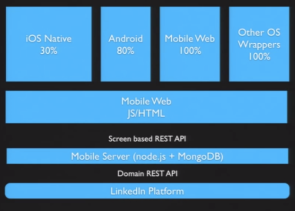iPhone and Android Mobile Applications: Native Code or Responsive Design?
by royalarse13
When building a brand new web application, should the developers opt for native code or responsive design? With a surplus of evidence supporting either approach finding a concrete solution is elusive. So what’s the best play?
Solve a complex problem with solution A or B? Nah, lets use A and B!
Old neck-beards would agree that delivering the best possible experience requires a blend of the two development methodologies. The magic is hidden inside common ground, where we’ll find objective c code peaceful commingling with javascript, HTML5/CSS3. How can we blend responsive design and device-native code to create the best possible application?
Like diagnosing ailments, app development is treated case-by-case, where differences in media, technology, expectations and budgets will create emergent flavours of mobile app development techniques.
Using LinkedIN as a test case, they find that the bottleneck in mobile apps is latency, not bandwidth, and the native code can help alleviate this, alongside sprocket-using node.js.
Interestingly, LinkedIn iOS app is 30/70 native-to-responsive, while their Android app inverts that ratio. As Chrome browser for Android becomes default, more of the codebase will move into javascript and away from java.
Don’t take my word for it, I stole these figures from this great video featuring the lead mobile developer at LinkedIN. Very informative talk, excellent use of your time if you’re interested in tech.
PS — Prototypes of their new apps are done in black and white, since shades and colours are influential during user testing. The addition of colour transformed the UI and UX in meaningfully as people respond to these visual stimuli in disparate ways.
